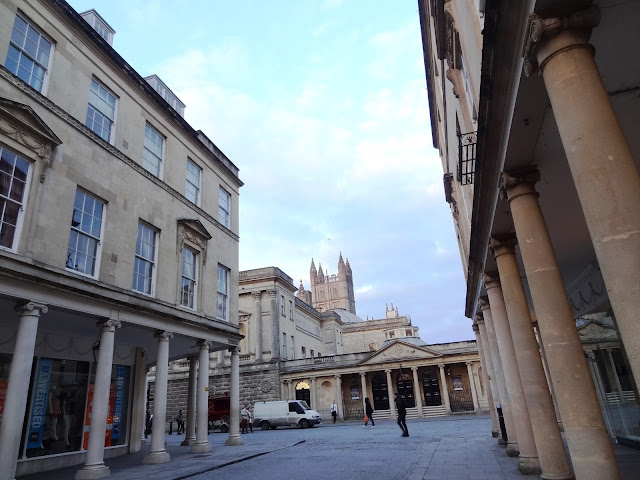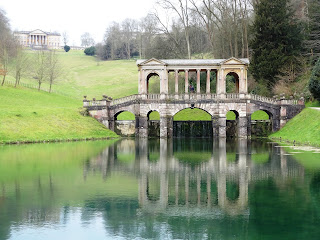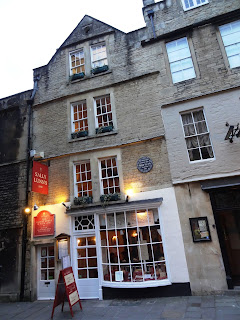One perfect occasion for a little trip is when both Friday and the following Monday are bank holidays. Our four-day Easter weekend in South West England was even nicer than expected, as the weather was nicer than usual, surprisingly in the cloudy and rainy England. We did experience some traffic jams the last day on the way back to west London, but it was nothing big that could cause a huge delay.
Day 1: Stonehenge + Salisbury Cathedral + Thermae Bath Spa

We departed at around 10:00 for Stonehenge, the famous prehistoric monument located around 1.5-hour drive southwest from west London. These remains of a ring of standing stones set within earthworks were probably built anywhere from 3000 BC to 2000 BC. According to archaeological evidence, Stonehenge could have been a burial ground from its earliest beginnings. The site and its surroundings have been listed as UNESCO World Heritage Sites since 1986. We had been told there was nothing but some stones and so seeing the site from outside the fence was more than enough. Some friends even suggested we exclude Stonehenge from the itinerary. After we had come so close to, and seen these stones from different angles, however, we confirmed the £8 entrance fee was well worth it for the magnificent views of the entire site.

Salisbury Cathedral, only 20-minute drive south from Stonehenge, might be the only big attraction in Salisbury. Parking just next to the site costs £6, so we went backwards to somewhere nearby and spent around £1 on off-street parking. Although commonly known as Salisbury Cathedral, the official name is the Cathedral of Saint Mary. This Anglican cathedral is considered a leading example of Early English architecture. It has the tallest church spire, largest cloister and the largest cathedral close in the United Kingdom. It also contains the world's oldest working clock. Entry to churches of this kind is usually free, but a voluntary donation is requested for its costly maintenance. No doubt the cathedral looks gorgeous outside, but the design of its interior sounds too blank. We did not spend that much time here before leaving for the next stop.

The plan of visiting Wilton House was called off, as it would not be a good idea to start the visit at almost 16:00 at an attraction that was closing in an hour. After another 1-hour journey on the road, we arrived in the beautiful city of Bath. We had been excited about the featured activity of this evening - Bath Spa, but we were then a bit shocked to see the long queue extended from Thermae Bath Spa to the street behind. On the left is a view of top of Bath Abbey and back of Roman Baths Pump Room & Museum from where we were in the queue for the Bath Spa. It took 40 minutes to wait for entry and it costed £26 per person for a 2-hour spa session. Bring your own slippers, towel, and robe, or you will need to pay for a rental. We had some good times in the “hot swimming pool”, but there was not anything extraordinary. Hot spring in Taiwan was much better.
Day 2: The City of Bath + Prior Park Landscape Garden + Sally Lunn’s Historic Eating House

Since main attractions are all packed together with the farthest one located only 18-minute walk away from the hotel, we spent most of the day exploring this beautiful City of Bath on foot. The first stop was Pulteney Bridge, which is a passage we must go through when we go to and from the hotel. Embedded in as part of the bridge there is a little cafe that overlooks a panorama of River Avon in the south. Parade gardens, where we could have got the best view of Pulteney Bridge, were supposed to be open, but it was closed. Luckily there is a footpath just opposite the gardens from which there is a very nice view of the bridge together with Victoria Art Gallery and a little fall of the river. The scene was especially breathtaking because of reflection of buildings in water and the azure sky.

The next two stops were The Circus and The Royal Crescent. Constructions in both sites are brilliant. By the Royal Avenue there is a spacious green from which we enjoyed a picture-postcard vista of the Crescent. We spent only a very short time there before going back south joining the crowd where Bath Abbey and Roman Baths stand. Commonly known as Bath Abbey, the Abbey Church of Saint Peter and Saint Paul in Bath is one significant example of Perpendicular Gothic architecture in the West Country. This cruciform church has been placed on the Statutory List of Buildings of Special Architectural or Historic Interest in the United Kingdom. The Abbey looks gorgeous both outside and inside. A view of which from outside together with the front of Roman Baths was one of my favorite.


Right next to Bath Abbey was our final stop in the City of Bath - Roman Baths Pump Room & Museum, probably the most notable attraction in the city. We had to queue for around 20 minutes, but the wait was not painful at all as we were pleased to have some nice shots of side views of Bath Abbey from where we were. We were not interested in the Fashion Museum of contemporary and historical dress, the entry fee was £12.75 per adult, instead of £16.25 for a combined ticket. Apart from the famous Great Bath, all other parts of the site are marvelous. There are The Terrace, Sacred Spring, Temple, People of Aquae Sulis, Temple Courtyard, Heated Pool & Plunge Pools, etc. Aided by the audio guide, we spent almost 4 hours to learn about the history and characteristics of these Roman Baths.


At around 14:30 we departed for Prior Park Landscape Garden, a beautiful 18th-century landscape garden located 5-minute drive away from City of Bath. Visitors’ best-loved historic icon is definitely the one of only four Palladian bridges of such design in the world. There is one other in Wilton House, a planned destination we missed on the first day. This Garden set in a sweeping valley that overlooks magnificent views of Bath also has trails leading to a circular route encompassing beautiful woodlands and meadows, an Iron Age hill fort, Roman settlements, etc. At around 17:30 we arrived at Sally Lunn’s Refreshment House back in City of Bath. After a visit into the mini-museum that showcases old-fashioned kitchens, we waited for 15 minutes to be seated and enjoy a late afternoon tea. I tried the Sally Lunn Bun, which was tasty!
Day 3: Cheddar Caves & Gorge + St Mary Redcliffe Church + Castle Combe
We departed at around ten for Cheddar Caves and Gorge, the largest gorge in the United Kingdom located 50-minute drive away from our accommodation in Bath. I had booked our tickets online in advance for a discounted price. For parking, we could have made some efforts to look for a space up the hill, instead of paying £5, even though the five was for a full day parking. The Gorge Bus Tour gave a brief introduction of the Caves & Gorge. Stalactites and stalagmites inside the scenic Gough’s Cave and Cox’s Cave were particularly awesome, while I would recommend to skip The Crystal Quest, unless you are travelling with kids. We had so much fun before ascending to the Lookout Tower and Cliff-Top Gorge Walk. The panorama of Cheddar Village was nice, but the Gorge itself was nothing exceptional.

Cheddar Caves were our favorite of the trip. We spent more than four hours there. At around 15:00 we headed northeast to St Mary Redcliffe Church in Bristol, a city located around 20 km northwest from Bath. Like Bath Abbey, the church is a Grade 1 listed building in the UK. This Anglican parish church is well-known for the beauty of its Gothic architecture. It is also the tallest building in Bristol. Queen Elizabeth I has described it as "the fairest, goodliest, and most famous parish church in England." From outside it does not look as charming as Salisbury Cathedral, but the architecture and fittings inside are far more exquisite. The Victorian stained-glass windows were created by some of the finest studios of that period. It was still early. At 16:00 we decided to go to Castle Combe, a destination originally scheduled for Day 4.

Renowned for its attractiveness and tranquility, and for fine buildings including a medieval St. Andrew's church, Castle Combe, a small village in Wiltshire, has been called “The Prettiest Village in England”. The village houses were constructed in stone with thick walls and roofs made from split natural stone tiles. The hundreds of years old properties are listed as ancient monuments, and therefore strict rules apply to preserve the beauty and character of the village. Residents need to arrange extra layers of double-glazed windows inside for cold weather, as they are not allowed to replace the original old windows. Castle Combe is a very pretty village. It is even smaller than I expected, but we spent quite a long time there to admire all those scenic spots and had enough nice shots until 19:00 when the sky was still blue.
Day 4: Farleigh Hungerford Castle + Nunney Castle + Windsor Castle

Since we had visited the pretty Castle Combe the precious day, there was extra time for extra destinations on Day 4. Farleigh Hungerford Castle and Nunney Castle are located 18-minute and 40-minute drive south of Bath respectively. Both medieval castles are in ruined condition. We had seen quite a lot of castles and palaces, but it was our first time to admire the ruins. The former is a Grade 1 listed building that fell into disrepair by the 18th century after Sir Edward Hungerford, the last member of the Hungerford family to hold the castle, needed to sell the property in 1686. The latter in Nunney was built in the late 14th century possibly influenced by the design of French castles, and was damaged during the English Civil War. It took around 1.5 hour to explore the entire Farleigh Hungerford, which costed £4.10 per entry; but a 15-minute visit was enough for Nunney.


We then headed northeast to Windsor Castle, which was the last stop of our trip on the way back to London. Due to traffic jams on this last day of Easter long weekend, it took almost 2.5 hours to drive from Nunney to Windsor. We had had no problem parking the car, but there in Windsor we spent 15 minutes to have the car finally parked, with a fee of £6.50 for only 3 hours. At around 14:20 we started to sightsee Windsor Castle. It is a big castle with gorgeous exterior. It is exactly the kind of fairy-tale castle I fancy. The entry fee of £17.75, however, is overpriced; because only a very few areas of this big castle are open to public. Unlike Palace of Versailles, for example, where you pay €18 to see the entire estate that would take a full day, we finished Windsor Castle in 2.5 hours, not to mention St. George Chapel was closed.


























